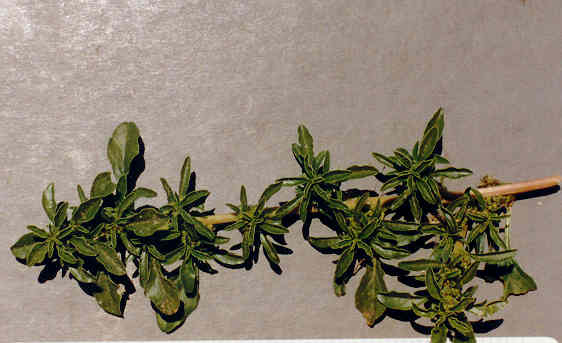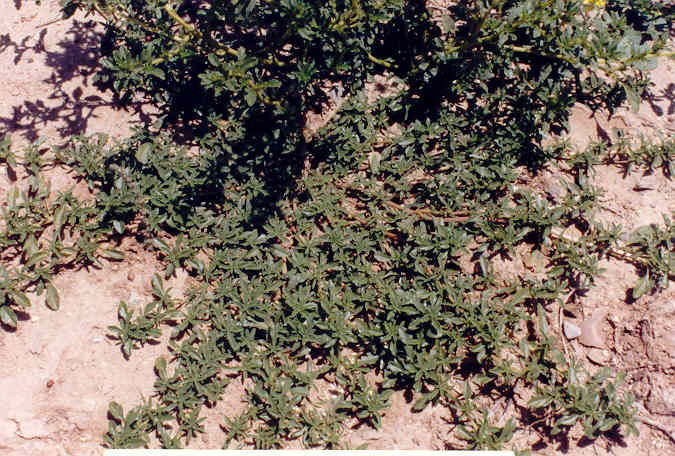
Amaranthus blitoides S. Watson
Amaranthaceae (Amaranth Family)
Native
 |
Amaranthus blitoides S. WatsonAmaranthaceae (Amaranth Family)Native
Prostrate Amaranth |
May Photo
Plant Characteristics:
Stems prostrate, 1-5 dm. long, branched from base, glabrous, often
purplish; lvs. many, often crowded, the petioles 2-15 mm. long, the blades
spatulate to obovate, 8-25 mm. long, pale green; monoecious; fls. in dense
axillary clusters usually shorter than petioles; bracts ovate-oblong, ca. as
long as sepals; sepals 4-5, in both male and female fls., oblong, acute or
acuminate, 2-3 mm. long; utricle scarcely rugose, equaling calyx; seeds round,
dull black, 1.5 mm. broad.
Habitat:
Occasional native weed in waste and cult. places below 5000 ft.; many
Plant Communities; widely scattered in Calif.; to Wash., Rocky Mts., Mex.
May-November
Name:
Greek, amarantos, unfading because of the dry persistent calyx and bracts.
(Munz, Flora So. Calif. 60).
Greek, bliton, name of a plant
of southern Europe. N.L. oides, a contraction of Gr. o+eidos,
denoting likeness of form, a thing that is like. (Jaeger 37, 172). Blitoides,
like some other plant. (my
comment).
General:
Rare in the study area, having been found only on the easterly side of
the Delhi Ditch. The specimen has
the characteristics of A. blitoides
with the exception that the seeds are shiny black when Abrams and Munz describe
them as dull black. Robbins et al.
describes the seeds as bright shining black.
Other authors do not mention this characteristic.
(my comments). In 2000, another specimen was found along Back Bay Dr. at the
road up to the Eastbluff burn area. This
specimen also had shiny black seeds and the immature fruit was reddish, a
characteristic not noted in any of the keys (my comments).
A. hypochondriacus has been
used as an astringent and detergent for piles.
It is excellent for excessive menstruation, leucorrhea, diarrhea,
dysentery, and hemorrhage from the bowels.
Simmer a teaspoonful of the stems and leaves in a pint of water for ten
minutes and drink freely for the above diseases.
An excellent gargle and wash for ulcers of the mouth and throat.
(Kloss 295).
Amaranthus species were important to all lower Colorado River Indians.
At full growth, amaranth turned brown and the branches were covered with
thorny pods holding tiny, black seeds. The
Cocopa Indians harvested these after the domesticated corn and beans had been
picked. Final preparation of the
seeds always took place just prior to the meal at which they would be eaten.
Seeds parched with coals in a pottery pan were ground on a stone with a mano and
the parched seed flour eaten as it was made or made into a mush. (Campbell 167).
About 50 species, widespread except in cold regions.
(Munz, Flora So. Calif. 60).
Text Ref:
Abrams, Vol. II 99; Hickman, Ed. 132; Munz, Flora
So. Calif. 61; Roberts 6.
Photo Ref:
May-June 93 # 18,20.
Identity: by R. De Ruff,
confirmed by John Johnson.
Computer Ref: Plant Data 451.
Have plant specimen.
Last edit 9/20/02.

|
May Photo